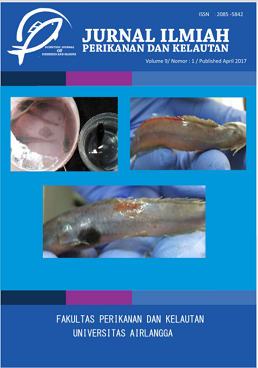Date Log
1. Copyright of the article is transferred to the journal, by the knowledge of the author, whilst the moral right of the publication belongs to the author.
2. The legal formal aspect of journal publication accessibility refers to Creative Commons Atribusi-Non Commercial-Share alike (CC BY-NC-SA), (https://creativecommons.org/licenses/by-nc-sa/4.0/)
3. The articles published in the journal are open access and can be used for non-commercial purposes. Other than the aims mentioned above, the editorial board is not responsible for copyright violation
The manuscript authentic and copyright statement submission can be downloaded ON THIS FORM.
Pengaruh Ekstrak Alga Merah (Kappaphycus alvarezii) terhadap Jumlah Total Bakteri dan Nilai Organoleptik Ikan Kembung (Rastrelliger sp.)
[ The Effect of Red Algae Extract (Kappaphycus alvarezii) against the Total Number of Bacteria and Organoleptic Value of Mackerel (Rastrelliger sp.)]
Corresponding Author(s) : Wahju Tjahyaningsih
Jurnal Ilmiah Perikanan dan Kelautan, Vol. 7 No. 1 (2015): JURNAL ILMIAH PERIKANAN DAN KELAUTAN
Abstract
Abstract
Mackerel (Rastrelliger sp.) is a kind of fish that have high economic value and good nutrition but susceptible to decay. People often to use formaldehyde as a preservative so that the fish does not quickly to decay. The use of formaldehyde could be replaced by natural ingredients that contain antibacterial compounds, one of which is Kappaphycus alvarezii. This study aims to determine the effect of red algae extract (K.alvarezii) against the total number of bacteria and organoleptic value of mackerel (Rastrelliger sp.). The research design that done in this study is Completely Randomized Design (CRD). The treatments that given are immersion of mackerel in a solution of extract of K. alvarezii with a concentration of 0 ppm, 600 ppm, 700 ppm, 800 ppm and 1% solution of formaldehyde with four repetitions in each treatment. Data analyzes using Analysis of Variants (ANOVA) and followed by Duncan's Multiple Range Test to determine differences between treatments. The results showed that the extract of red algae (K.alvarezii) at a concentration of 0 ppm, 600 ppm, 700 ppm and 800 ppm significantly (p <0.05) against the total number of bacteria of mackerel (Rastrelliger sp.). The ability of extract of K. alvarezii at a concentration of 800 ppm equivalent to the ability of formaldehyde as an antibacterial ingredient in mackerel. K.alvarezii extract could inhibit the growth of bacteria but have not been able to maintain the quality of mackerel based on organoleptic test.
Keywords
Download Citation
Endnote/Zotero/Mendeley (RIS)BibTeX
- Ajizah, A. 2004. Sensitivitas Salmonella typhimurium terhadap Ekstrak Daun Psidium Guajava L. Bioscientiae, 1 (1) : 31-38.
- Alam, G., Mufidah, M. Nasrum, F. Kurnia, Abd. Rahim dan Usmar. 2012. Skrinning Komponen Kimia dan Uji Aktivitas Mukolitik Ekstrak Rimpang Bangle (Zingiber purpureum Roxb.) terhadap Mukosa Usus Sapi Secara In Vitro. Majalah Farmasi dan Farmakologi, 16 (3) : 123-126.
- Anjarsari, B. 2010. Pangan Hewani Fisiologi Pasca Mortem dan Teknologi. Graha Ilmu. Yogyakarta. hal. 119.
- Cowan, M. M. 1999. Plant Product as Antimicrobial Agent. Clinical Microbiology Reviews, 12 (4) : 564582.
- Florensia, S., P. Dewi dan N. R. Utami. 2012. Pengaruh Ekstrak Lengkuas pada Perendaman Ikan Bandeng terhadap Jumlah Bakteri. Unnes Journal of Life Science, 1 (2) : 113-118.
- Hamid, A. A., R. Rosita dan Y. Q. Mondiani. 2011. Potensi Ekstrak Etanol Kulit Kayu Pohon Rambutan (Nephelium lappaecum L.) dalam Menghambat Pertumbuhan Bakteri Salmonella Typhi secara in vitro. Jurnal Penelitian. Universitas Brawijaya. hal. 7.
- Irianto, H. E dan I. Soesilo. 2007. Dukungan Teknologi Penyediaan Produk Perikanan. Makalah pada Seminar Nasional Hari Pangan Sedunia, 21 November 2007.
- Badan Riset Kelautan dan Perikanan. Depertemen Kelautan dan Perikanan. Bogor. hal. 16. Kusriningrum. 2008. Perancangan Percobaan. Airlangga University Press. Surabaya. hal. 77-86.
- Liviawaty, E. dan E. Afrianto. 2010. Penanganan Ikan Segar. Widya Padjajaran. Bandung. hal. 24-56.
- Munandar, A., Nurjanah dan M. Nurilmala. 2009. Kemunduran Mutu Ikan Nila (Oreochromis niloticus) pada Penyimpanan Suhu Rendah dengan Perlakuan Cara Kematian dan Penyiangan. Jurnal Teknologi Pengolahan Hasil Perikanan Indonesia, XII (2) : 88-101.
References
Ajizah, A. 2004. Sensitivitas Salmonella typhimurium terhadap Ekstrak Daun Psidium Guajava L. Bioscientiae, 1 (1) : 31-38.
Alam, G., Mufidah, M. Nasrum, F. Kurnia, Abd. Rahim dan Usmar. 2012. Skrinning Komponen Kimia dan Uji Aktivitas Mukolitik Ekstrak Rimpang Bangle (Zingiber purpureum Roxb.) terhadap Mukosa Usus Sapi Secara In Vitro. Majalah Farmasi dan Farmakologi, 16 (3) : 123-126.
Anjarsari, B. 2010. Pangan Hewani Fisiologi Pasca Mortem dan Teknologi. Graha Ilmu. Yogyakarta. hal. 119.
Cowan, M. M. 1999. Plant Product as Antimicrobial Agent. Clinical Microbiology Reviews, 12 (4) : 564582.
Florensia, S., P. Dewi dan N. R. Utami. 2012. Pengaruh Ekstrak Lengkuas pada Perendaman Ikan Bandeng terhadap Jumlah Bakteri. Unnes Journal of Life Science, 1 (2) : 113-118.
Hamid, A. A., R. Rosita dan Y. Q. Mondiani. 2011. Potensi Ekstrak Etanol Kulit Kayu Pohon Rambutan (Nephelium lappaecum L.) dalam Menghambat Pertumbuhan Bakteri Salmonella Typhi secara in vitro. Jurnal Penelitian. Universitas Brawijaya. hal. 7.
Irianto, H. E dan I. Soesilo. 2007. Dukungan Teknologi Penyediaan Produk Perikanan. Makalah pada Seminar Nasional Hari Pangan Sedunia, 21 November 2007.
Badan Riset Kelautan dan Perikanan. Depertemen Kelautan dan Perikanan. Bogor. hal. 16. Kusriningrum. 2008. Perancangan Percobaan. Airlangga University Press. Surabaya. hal. 77-86.
Liviawaty, E. dan E. Afrianto. 2010. Penanganan Ikan Segar. Widya Padjajaran. Bandung. hal. 24-56.
Munandar, A., Nurjanah dan M. Nurilmala. 2009. Kemunduran Mutu Ikan Nila (Oreochromis niloticus) pada Penyimpanan Suhu Rendah dengan Perlakuan Cara Kematian dan Penyiangan. Jurnal Teknologi Pengolahan Hasil Perikanan Indonesia, XII (2) : 88-101.
